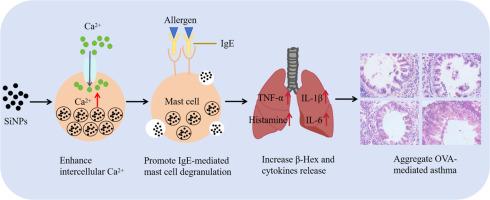Silica nanoparticles interfere with mast cell activation by enhancing intracellular Ca2+ levels and aggravate ovalbumin-mediated asthma
IF 2.7
引用次数: 0
Abstract
Silica nanoparticles (SiNPs) exist widely in the environment. The likelihood of people being exposed to SiNPs has increased dramatically, and its biosafety bring a great concern. Mast cells are a type of key effector cells that mediate the occurrence of allergic reactions through IgE and non-IgE activation pathways.To date, the effects of SiNPs on these two activation pathways of mast cells remain unclear. In this study, RBL-2H3 cells and ovalbumin (OVA) asthma mice were used to investigate the effects of SiNPs on mast cell activation and its mediating asthma. in vitro studies, SiNPs significantly promoted the release of inflammatory factors TNF-α and IL-1β, but didn’t affect the release of β-Hex (degranulation) in the C48/80-mediated non-IgE activation pathway. In the IgE activation pathway, SiNPs significantly enhanced the release of TNF-α and IL-1β, and also promoted mast cell degranulation by increasing intracellular Ca2+ levels. in vivo study, respiratory exposure to SiNPs significantly enhanced the serum histamine and the levels of cytokines (IL-6, TNF-α and IL-1β) in bronchoalveolar lavage fluid (BALF) from asthmatic mice sensitized, thickened the airway walls, increased the inflammatory cells infiltration and the number of mast cells, suggesting that SiNPs significantly aggravated OVA-mediated asthma in mice. These findings reveal the effects of SiNPs on mast cells and their mediated allergic reactions, providing scientific clues for the prevention and treatment of allergic diseases, especially asthma.

二氧化硅纳米颗粒通过增强细胞内Ca2+水平干扰肥大细胞活化,加重卵清蛋白介导的哮喘
二氧化硅纳米颗粒(SiNPs)广泛存在于环境中。人们接触到sinp的可能性急剧增加,其生物安全性引起极大关注。肥大细胞是一类通过IgE和非IgE激活途径介导过敏反应发生的关键效应细胞。迄今为止,SiNPs对肥大细胞这两种激活途径的影响尚不清楚。本研究以RBL-2H3细胞和卵清蛋白(OVA)哮喘小鼠为研究对象,探讨SiNPs对肥大细胞活化及其介导哮喘的影响。在体外研究中,SiNPs显著促进炎症因子TNF-α和IL-1β的释放,但不影响c48 /80介导的非ige激活途径中β-Hex(脱颗粒)的释放。在IgE激活途径中,SiNPs显著增强TNF-α和IL-1β的释放,并通过增加细胞内Ca2+水平促进肥大细胞脱颗粒。体内实验结果显示,呼吸暴露于SiNPs显著提高哮喘小鼠的血清组胺和支气管肺泡灌洗液(BALF)中细胞因子(IL-6、TNF-α和IL-1β)水平,使气道壁增厚,炎症细胞浸润和肥大细胞数量增加,提示SiNPs显著加重ova介导的哮喘小鼠。这些发现揭示了SiNPs对肥大细胞及其介导的过敏反应的作用,为过敏性疾病特别是哮喘的预防和治疗提供了科学线索。
本文章由计算机程序翻译,如有差异,请以英文原文为准。
求助全文
约1分钟内获得全文
求助全文
来源期刊

Hygiene and environmental health advances
Environmental Science (General)
CiteScore
1.10
自引率
0.00%
发文量
0
审稿时长
38 days
 求助内容:
求助内容: 应助结果提醒方式:
应助结果提醒方式:


